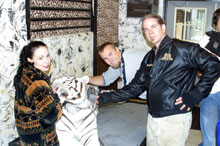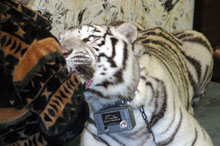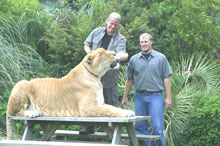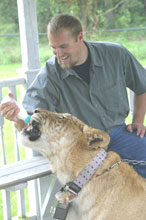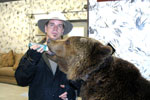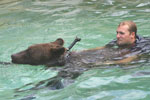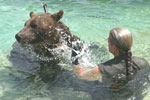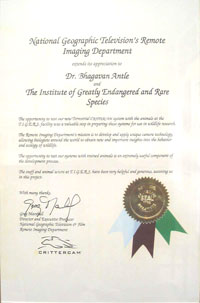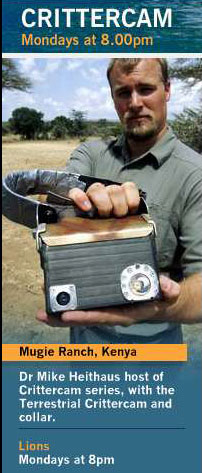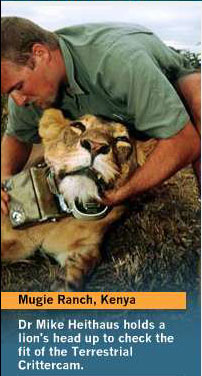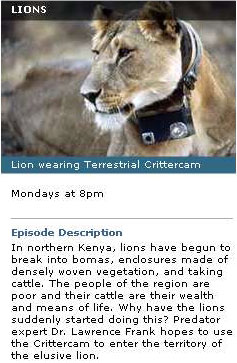  |
|
  |
|
 |
|
After working out some minor quirks, it was time to head outside and see how well they could receive video from and control the unit. They have really created an amazing piece of research technology. The Crittercam contains a full color camera that also has an IR mode for nightvision recordings. The unit is very light and rugged and is controlled through a PDA. They can tell the camera to record, switch features of the camera on and off, and even cause a slide-bolt in the collar to open which allows the camera to fall of the animal for retreival. All in all, they can operate the camera for around 15 hours and it has a safe-mode which only allows for 5 minute increments of video at a time. This way if the animal is out of range, the camera automatically shuts off to allow the battery life to be saved. This allows them to choose which footage they want to record which gives researchers great control. After testing the big cat Crittercam throughout the day and night, it was time to move onto GrizzlyCam. It actually took them a bit of brainstorming to come up with a system that would work on a bear. The system created for the big cats just didn't fit properly on a bear. The bear version of the camera is more of a snorkel sticking off the back of the bears neck with the battery and components counterweighing the camera. Quite the unique looking device and waterproof too. After a few visits from National Geographic Television's Remote Imaging Department, they managed to work out most of the quirks from the system and were ready to take it into the wild. There were certainly some entertaining moments during the trials for both the animals and the people. They learned that cameras on bears will never stay straight, antennas need to be really tough for big cats, a tiger can undo zip-ties in a second and run away with your prized Crittercam (great footage), a Crittercam better be bite-proof and waterproof, and technology never works like it should. As a sign of their appreciation, National Geographic gave us this certificate which states: "National Geographic Television's Remote Imaging Department extends its appreciation to Dr. Bhagavan
Antle and The Institute of Greatly Endangered and Rare Species. The opportunity to test our new Terrestrial CRITTERCAM
system with the animals at the T.I.G.E.R.S. facility was a valuable step in preparing these systems for use in wildlife
research. The Remote Imaging Deparment's mission is to develop and apply unique camera technology, allowing biologists
around the world to obtain new and important insights into the behavior and ecology of wildlife. The opportunity to test
our systems with trained animals is an extremely useful component of the development process. The staff and animal actors
of T.I.G.E.R.S. have been very helpful and generous, assisting us in this project. They also sent us another letter: "Granted to: T.I.G.E.R.S. (The Institute of Greatly Endangered and Rare Species) under the supervision of Bhagavan "Doc" Antle for their generous contribution to the research efforts of National Geographic Television's Remote Imaging Program. The use of captive animals at the T.I.G.E.R.S. facility enables our researchers and producers to gather essential data and information that would otherwise be difficult to achieve without the cooperation of trained animals and their handlers. The understandings that are derived from our research endeavors provide conservation benefits to wild populations of similar animals and educational opportunities for the general public." Our mission at T.I.G.E.R.S. is to promoting global conservation with the aid of our trained animal ambassadors. We were grateful for the opportunity to help National Geographic develop a new cutting edge research technology which will undoubtedly help strengthen the overall understanding of wildlife behavior and assist in global wildlife conservation. A new insight into the lives of these animals could bring us closer to saving them than ever before. Be sure to watch the first research with the Terrestrial Crittercam on National Geographic.
|
| © Tiger Friends 1997 | Site by Zeal |
Special thanks to Chris Heiden for the many hours of hard work devoted to creating images and content for the website. No part of this web page may be reproduced, stored in or introduced into a retrieval system, or transmitted, in whole or in part, by any means (electronic, mechanical, photocopying, recording, or otherwise) without express written permission of T.I.G.E.R.S. T.I.G.E.R.S., and The Institute of Greatly Endangered and Rare Species
are trademarks of: |
|


